

Compact Muon Solenoid
LHC, CERN
| CMS-HIN-21-011 ; CERN-EP-2023-094 | ||
| Two-particle Bose-Einstein correlations and their Lévy parameters in PbPb collisions at $ \sqrt{\smash[b]{s_{_{\mathrm{NN}}}}} = $ 5.02 TeV | ||
| CMS Collaboration | ||
| 20 June 2023 | ||
| Phys. Rev. C 109 (2024) 024914 | ||
| Abstract: Two-particle Bose-Einstein momentum correlation functions are studied for charged-hadron pairs in lead-lead collisions at a center-of-mass energy per nucleon pair of $ \sqrt{\smash[b]{s_{_{\mathrm{NN}}}}} = $ 5.02 TeV. The data sample, containing 4.27 10$^{9}$ minimum bias events corresponding to an integrated luminosity of 0.607 nb$^{-1}$, was collected by the CMS experiment in 2018. The experimental results are discussed in terms of a Lévy-type source distribution. The parameters of this distribution are extracted as functions of particle pair average transverse mass and collision centrality. These parameters include the Lévy index or shape parameter ($ \alpha $), the Lévy scale parameter ($ R $), and the correlation strength parameter ($ \lambda $). The source shape, characterized by $ \alpha $, is found to be neither Cauchy nor Gaussian, implying the need for a full Lévy analysis. Similarly to what was previously found for systems characterized by Gaussian source radii, a hydrodynamical scaling is observed for the Lévy $ R $ parameter. The $ \lambda $ parameter is studied in terms of the core-halo model. | ||
| Links: e-print arXiv:2306.11574 [hep-ex] (PDF) ; CDS record ; inSPIRE record ; HepData record ; CADI line (restricted) ; | ||
| Figures | |
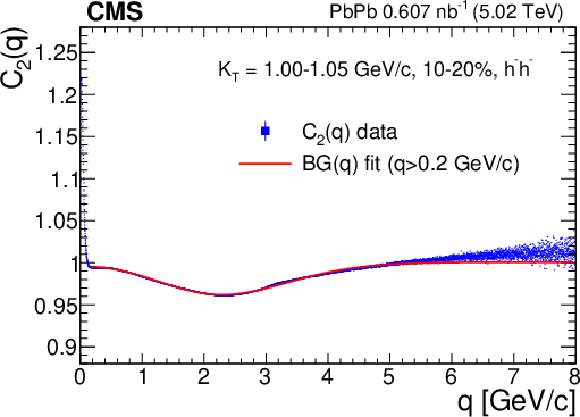
png pdf |
Figure 1:
An example of a long range background fit to the correlation function $ C_2(q) $ of negatively charged hadron pairs with 1.00 $ < K_{\mathrm{T}} < $ 1.05 GeV/$c$ in the 10-20% centrality bin. The Bose-Einstein peak is below $ q=$ 0.2 GeV/$c$, therefore the 0.2 $ < q < $ 8.0 GeV/$c$ region was used for the long range background fit. |

png pdf |
Figure 2:
An example fit to the double-ratio correlation function $ DR(q) $ of negatively charged hadron pairs with 1.30 $ < K_{\mathrm{T}} < $ 1.35 GeV/$c$ in the 20-30% centrality bin. The error bars show the statistical uncertainties. The fitted function is shown in blue, while the red overlay indicates the range used for the fit. The size of the Coulomb correction is indicated in magenta. The lower panel shows the deviation of the fit from the data in each bin in units of the standard deviation in that bin. |
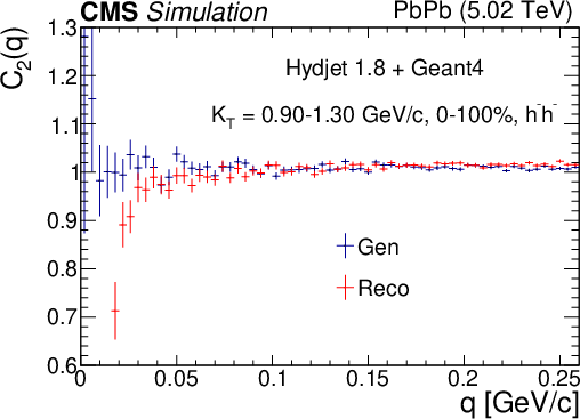
png pdf |
Figure 3:
The two-particle correlation function of negatively charged hadron pairs with 0.9 $ < K_{\mathrm{T}} < $ 1.3 GeV/$c$ in the 0-100% centrality range, calculated using Monte Carlo events with (Reco) and without (Gen) detector reconstruction effects. The error bars show the statistical uncertainties. The detector effects are most significant below approximately 50 MeVc. The quantum-statistical effects are not present in the simulations, hence there is no Bose-Einstein peak. |
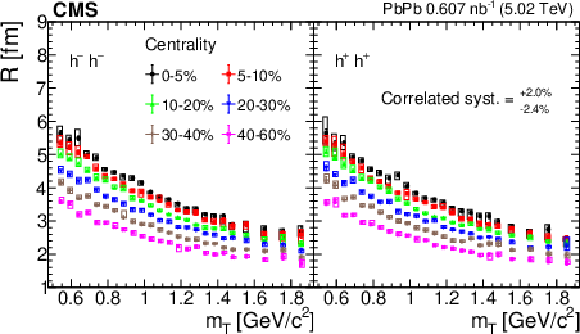
png pdf |
Figure 4:
The Lévy scale parameter $ R $ versus the transverse mass $ m_{\mathrm{T}} $ in different centrality classes, for negatively (left) and positively (right) charged hadron pairs. The error bars show the statistical uncertainties, while the boxes indicate the point-to-point systematic uncertainties. These boxes are slightly shifted along the horizontal axes for better visibility. The correlated systematic uncertainty is also indicated. |

png pdf |
Figure 5:
The 1/$ R^2 $ distribution vs. transverse mass $ m_{\mathrm{T}} $ in different centrality classes, for negatively (left) and positively (right) charged hadron pairs. The error bars show the statistical uncertainties, while the boxes indicate the point-to-point systematic uncertainties. These boxes are slightly shifted along the horizontal axes for better visibility. The correlated systematic uncertainty is also indicated. A linear fit to the data is shown for each centrality bin. The fit parameters are tabulated in Table 3. |
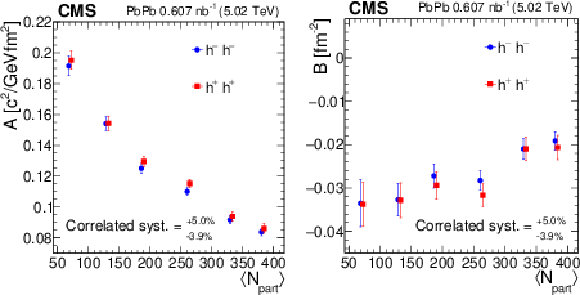
png pdf |
Figure 6:
The slope $ A $ (left) and the intercept $ B $ (right) linear-fit parameters versus $ \langle N_{\text{part}}\rangle $, for positively and negatively charged hadron pairs. The error bars show the statistical uncertainties. The correlated systematic uncertainty is also indicated. The points are slightly shifted along the horizontal axes for better visibility. |
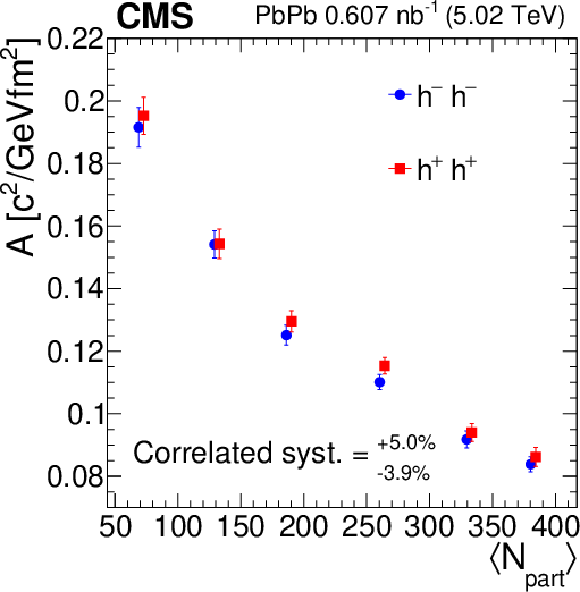
png pdf |
Figure 6-a:
The slope $ A $ linear-fit parameter versus $ \langle N_{\text{part}}\rangle $, for positively and negatively charged hadron pairs. The error bars show the statistical uncertainties. The correlated systematic uncertainty is also indicated. The points are slightly shifted along the horizontal axes for better visibility. |
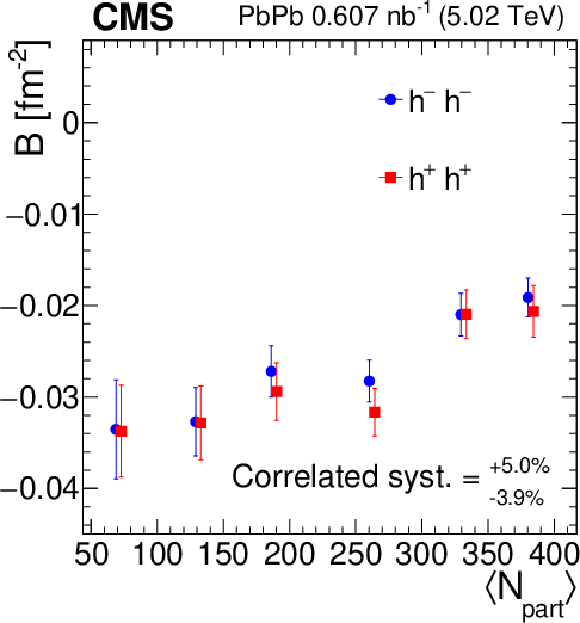
png pdf |
Figure 6-b:
The intercept $ B $ linear-fit parameter versus $ \langle N_{\text{part}}\rangle $, for positively and negatively charged hadron pairs. The error bars show the statistical uncertainties. The correlated systematic uncertainty is also indicated. The points are slightly shifted along the horizontal axes for better visibility. |
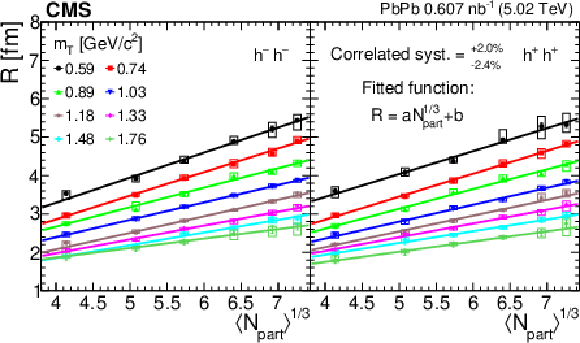
png pdf |
Figure 7:
The Lévy scale parameter $ R $ versus $ \langle N_{\text{part}}\rangle^{1/3} $ in different $ m_{\mathrm{T}} $ classes, for negatively (left) and positively (right) charged hadron pairs. The error bars show the statistical uncertainties, while the boxes indicate the point-to-point systematic uncertainties. The correlated systematic uncertainty is also indicated. A linear fit to the data is shown for each $ m_{\mathrm{T}} $ class. The fit parameters are tabulated in Table 4. |
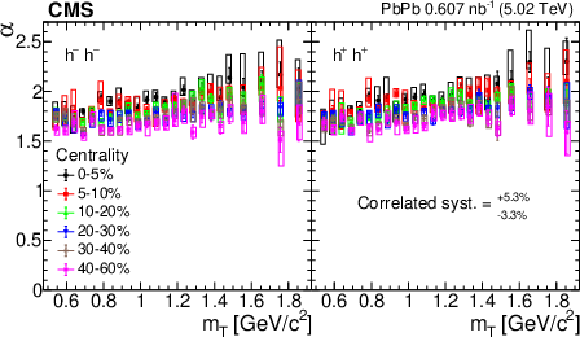
png pdf |
Figure 8:
The Lévy stability index $ \alpha $ versus the transverse mass $ m_{\mathrm{T}} $ in different centrality classes, for negatively (left) and positively (right) charged hadron pairs. The error bars show the statistical uncertainties, while the boxes indicate the point-to-point systematic uncertainties. These boxes are slightly shifted along the horizontal axes for better visibility. The correlated systematic uncertainty is also indicated. |
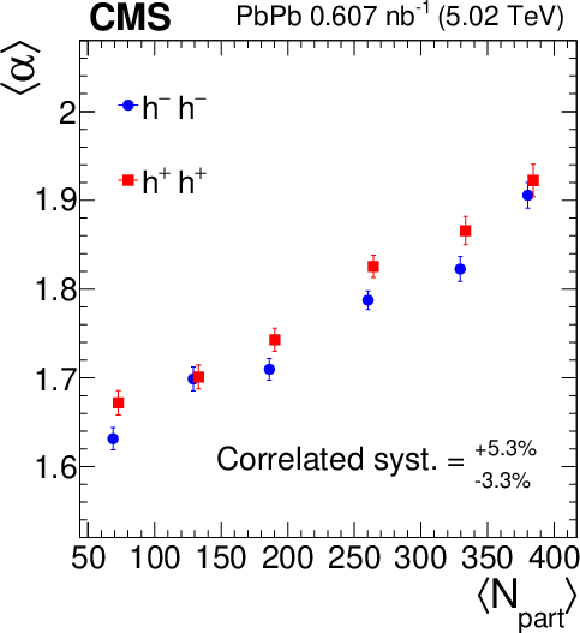
png pdf |
Figure 9:
The average Lévy stability index $ \langle \alpha \rangle $ versus $ \langle N_{\text{part}}\rangle $, for both positively and negatively charged hadron pairs. The error bars show the statistical uncertainties. The correlated systematic uncertainty is also indicated. The points are slightly shifted along the horizontal axes for better visibility. |

png pdf |
Figure 10:
The correlation strength $ \lambda $ (upper panel) and $ \lambda^* $, which is re-scaled with the square of the pion fraction (lower panel), versus the transverse mass $ m_{\mathrm{T}} $ in different centrality classes, for negatively (left) and positively (right) charged hadron pairs. The error bars show the statistical uncertainties, while the boxes indicate the point-to-point systematic uncertainties. These boxes are slightly shifted along the horizontal axes for better visibility. The correlated systematic uncertainty is also indicated. |
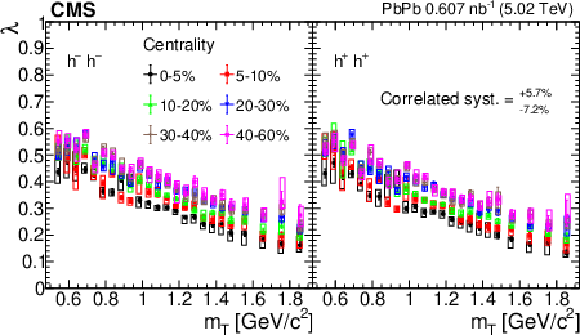
png pdf |
Figure 10-a:
The correlation strength $ \lambda $ versus the transverse mass $ m_{\mathrm{T}} $ in different centrality classes, for negatively (left) and positively (right) charged hadron pairs. The error bars show the statistical uncertainties, while the boxes indicate the point-to-point systematic uncertainties. These boxes are slightly shifted along the horizontal axes for better visibility. The correlated systematic uncertainty is also indicated. |
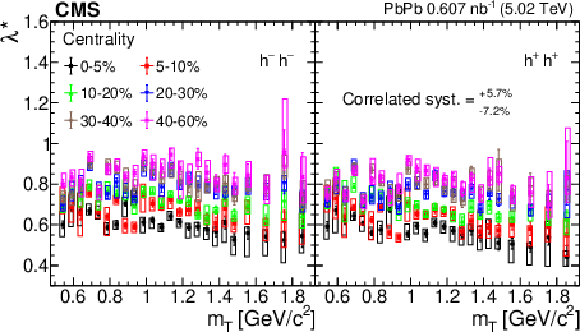
png pdf |
Figure 10-b:
$ \lambda^* $, which is re-scaled with the square of the pion fraction, versus the transverse mass $ m_{\mathrm{T}} $ in different centrality classes, for negatively (left) and positively (right) charged hadron pairs. The error bars show the statistical uncertainties, while the boxes indicate the point-to-point systematic uncertainties. These boxes are slightly shifted along the horizontal axes for better visibility. The correlated systematic uncertainty is also indicated. |
| Tables | |
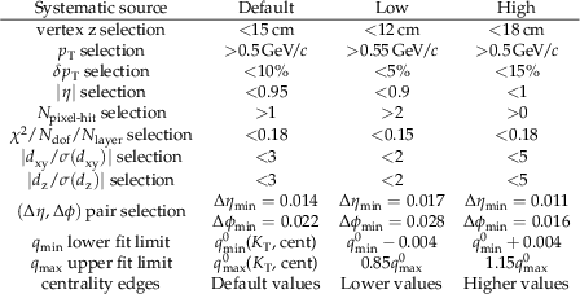
png pdf |
Table 1:
The sources of the systematic uncertainties with their values in the default and lower/upper settings. The meaning of the analysis parameters are given in Sections 4.1 and 4.2. |
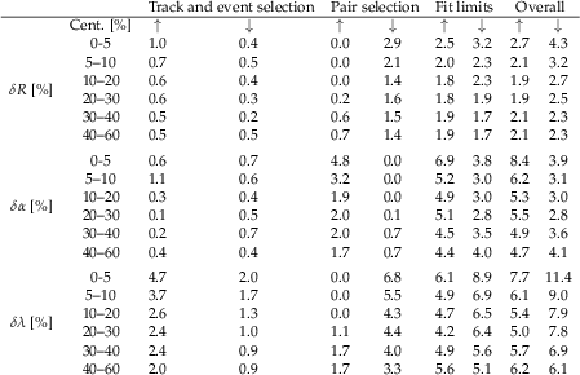
png pdf |
Table 2:
The relative effect of the different types of systematic sources in each centrality class for the $ R $ (upper Table), $ \alpha $ (middle Table) and $ \lambda $ (lower Table) parameters (in percentage). The values were averaged over $ K_{\mathrm{T}} $ and the two charge signs; the upwards (downwards) arrow, $ \uparrow $ ($ \downarrow $) represents positive (negative) uncertainty in the value of the final fit parameters. |

png pdf |
Table 3:
Fit parameters and the corresponding confidence levels (CL) of the linear fits to 1/$ R^2 $ versus $ m_{\mathrm{T}} $, for positively (left) and negatively (right) charged hadron pairs. |

png pdf |
Table 4:
Fit parameters and the corresponding confidence levels (CL) of the linear fits to $ R $ versus $ \langle N_{\text{part}}\rangle^{1/3} $, for positively (left) and negatively (right) charged hadron pairs. |
| Summary |
| Two-particle Bose-Einstein momentum correlation function measurements are presented. The data sample consists of 4.27 10$^{9}$ minimum bias lead-lead (PbPb) events, corresponding to an integrated luminosity of 0.607 nb$^{-1}$, at a center-of-mass energy per nucleon pair of $ \sqrt{\smash[b]{s_{_{\mathrm{NN}}}}} = $ 5.02 TeV, recorded by the CMS experiment at the LHC. The correlation functions found in different centrality and average transverse momentum classes are analyzed in terms of Lévy sources, including Coulomb effects. The values of the Lévy scale parameter $ R $, the Lévy stability index $ \alpha $, and the correlation strength $ \lambda $ are determined. A geometric interpretation of the $ R $ parameter is suggested by its dependence on the average number of participating nucleons in the collision. Assuming a pion mass for the charged particles, a linear dependence of 1/$ R^2 $ on the transverse mass ($ m_{\mathrm{T}} $) is observed, consistent with a hydrodynamic scaling behavior, even for the case of Lévy sources. Based on the observed linear behavior, it is estimated that the Hubble constant of the quark-gluon plasma created in 5.02 TeV PbPb collisions increases from 0.11\ensuremath{\unit $ c $/fm}} to 0.18\ensuremath{\unit $ c $/fm}} when moving from most central to most peripheral collisions. The intercept of the 1/$ R^2 $ versus $ m_{\mathrm{T}} $ linear fits is negative in all cases, requiring further studies for its interpretation. The $ \alpha $ parameter is found to have little, if any, $ m_{\mathrm{T}} $ dependence and to range between 1.6-2.0, increasing with centrality. The $ \alpha $ values found in this paper are approximately 45-60% larger than those reported for gold-gold collisions at $ \sqrt{\smash[b]{s_{_{\mathrm{NN}}}}} = $ 200 GeV at RHIC. This increase, while not fully understood, may result from the greater energy densities achieved at the LHC. As a function of $ m_{\mathrm{T}} $, a strong and decreasing trend is observed for the $ \lambda $ parameter, which can be explained by the lack of particle identification. After rescaling the $ \lambda $ values to account for the fraction of pions among the charged hadrons, a nearly constant trend of the pion-fraction-corrected $ \lambda^* $ with $ m_{\mathrm{T}} $ is observed. The $ \lambda^* $ values are found to be smaller than unity, which can be interpreted on the basis of the core-halo model as a non-negligible halo contribution. Furthermore, $ \lambda^* $ is found to decrease as the collisions become more central. Altogether, these results imply that the hadron emitting source in $ \sqrt{\smash[b]{s_{_{\mathrm{NN}}}}} = $ 5.02 TeV PbPb collisions can be described by Lévy distributions. This allows for a new and precise characterization of this source in high-energy heavy ion collisions. |
| References | ||||
| 1 | G. Goldhaber, W. B. Fowler, S. Goldhaber, and T. F. Hoang | Pion-pion correlations in antiproton annihilation events | PRL 3 (1959) 181 | |
| 2 | G. Goldhaber, S. Goldhaber, W.-Y. Lee, and A. Pais | Influence of Bose-Einstein statistics on the antiproton proton annihilation process | PR 120 (1960) 300 | |
| 3 | R. J. Glauber | Photon correlations | PRL 10 (1963) 84 | |
| 4 | R. J. Glauber | Nobel lecture: One hundred years of light quanta | Rev. Mod. Phys. 78 (2006) 1267 | |
| 5 | R. J. Glauber | Quantum optics and heavy ion physics | Nucl. Phys. A 774 (2006) 3 | nucl-th/0604021 |
| 6 | R. Hanbury Brown and R. Q. Twiss | A test of a new type of stellar interferometer on Sirius | Nature 178 (1956) 1046 | |
| 7 | R. Lednicky | Femtoscopy with unlike particles | in International Workshop on the Physics of the Quark Gluon Plasma, 2001 | nucl-th/0112011 |
| 8 | PHENIX Collaboration | Bose-Einstein correlations of charged pion pairs in Au+Au collisions at $ \sqrt{\smash[b]{s_{_{\mathrm{NN}}}}} = $ 200 GeV | PRL 93 (2004) 152302 | nucl-ex/0401003 |
| 9 | NA44 Collaboration | Two kaon correlations in central Pb+Pb collisions at 158A GeVc | PRL 87 (2001) 112301 | nucl-ex/0107005 |
| 10 | PHENIX Collaboration | Kaon interferometric probes of space-time evolution in Au+Au collisions at $ \sqrt{\smash[b]{s_{_{\mathrm{NN}}}}} = $ 200 GeV | PRL 103 (2009) 142301 | 0903.4863 |
| 11 | A. N. Makhlin and Y. M. Sinyukov | Hydrodynamics of hadron matter under pion interferometric microscope | Z. Phys. C 39 (1988) 69 | |
| 12 | T. Csörgó and B. Lörstad | Bose-Einstein correlations for three-dimensionally expanding, cylindrically symmetric, finite systems | PRC 54 (1996) 1390 | hep-ph/9509213 |
| 13 | M. Csanád, T. Csörgó, B. Lörstad, and A. Ster | Indication of quark deconfinement and evidence for a Hubble flow in 130 GeV and 200 GeV Au+Au collisions | JPG 30 (2004) S1079 | nucl-th/0403074 |
| 14 | S. Pratt | Resolving the HBT puzzle in relativistic heavy ion collision | PRL 102 (2009) 232301 | 0811.3363 |
| 15 | R. A. Lacey | Indications for a critical end point in the phase diagram for hot and dense nuclear matter | PRL 114 (2015) 142301 | 1411.7931 |
| 16 | STAR Collaboration | Pion interferometry in Au+Au collisions at $ \sqrt{\smash[b]{s_{_{\mathrm{NN}}}}} = $ 200 GeV | PRC 71 (2005) 044906 | nucl-ex/0411036 |
| 17 | ALICE Collaboration | One-dimensional pion, kaon, and proton femtoscopy in Pb-Pb collisions at $ \sqrt{\smash[b]{s_{_{\mathrm{NN}}}}} = $ 2.76 TeV | PRC 92 (2015) 054908 | 1506.07884 |
| 18 | CMS Collaboration | Bose-Einstein correlations in pp, pPb, and PbPb collisions at $ \sqrt{\smash[b]{s_{_{\mathrm{NN}}}}} = $ 0.9-7 TeV | PRC 97 (2018) 064912 | CMS-FSQ-14-002 1712.07198 |
| 19 | ATLAS Collaboration | Femtoscopy with identified charged pions in proton-lead collisions at $ \sqrt{\smash[b]{s_{_{\mathrm{NN}}}}} = $ 5.02 TeV with ATLAS | PRC 96 (2017) 064908 | 1704.01621 |
| 20 | PHENIX Collaboration | Lévy-stable two-pion Bose-Einstein correlations in $ \sqrt{\smash[b]{s_{_{\mathrm{NN}}}}} = $ 200 GeV Au+Au collisions | PRC 97 (2018) 064911 | 1709.05649 |
| 21 | NA61/SHINE Collaboration | Measurements of two-pion HBT correlations in Be+Be collisions at 150A GeV/c beam momentum, at the NA61/SHINE experiment at CERN | 2302.04593 | |
| 22 | V. V. Uchaikin and V. M. Zolotarev | Chance and stability: stable distributions and their applications | De Gruyter, . , ISBN~978315974, 2011 link |
|
| 23 | T. Csörgó, S. Hegyi, T. Novák, and W. A. Zajc | Bose-Einstein or HBT correlations and the anomalous dimension of QCD | Acta Phys. Polon. B 36 (2005) 329 | hep-ph/0412243 |
| 24 | T. Csörgó, S. Hegyi, T. Novák, and W. A. Zajc | Bose-Einstein or HBT correlation signature of a second order QCD phase transition | AIP Conf. Proc. 828 (2006) 525 | nucl-th/0512060 |
| 25 | M. Csanád, T. Csörgó, and M. Nagy | Anomalous diffusion of pions at RHIC | Braz. J. Phys. 37 (2007) 1002 | hep-ph/0702032 |
| 26 | D. Kincses, M. Stefaniak, and M. Csanád | Event-by-event investigation of the two-particle source function in heavy-ion collisions with EPOS | Entropy 24 (2022) 308 | 2201.07962 |
| 27 | B. Kórodi, D. Kincses, and M. Csanád | Event-by-event investigation of the two-particle source function in $ {\sqrt{\smash[b]{s_{_{\mathrm{NN}}}}}}= $ 2.76 TeV PbPb collisions with EPOS | 2212.02980 | |
| 28 | CMS Collaboration | HEPData record for this analysis | link | |
| 29 | T. Csörgó | Particle interferometry from 40 MeV to 40 TeV | Acta Phys. Hung. A 15 (2002) 1 | hep-ph/0001233 |
| 30 | U. A. Wiedemann and U. W. Heinz | Particle interferometry for relativistic heavy ion collisions | Phys. Rept. 319 (1999) 145 | nucl-th/9901094 |
| 31 | J. Bolz et al. | Resonance decays and partial coherence in Bose-Einstein correlations | PRD 47 (1993) 3860 | |
| 32 | T. Csörgó, B. Lörstad, and J. Zimányi | Bose-Einstein correlations for systems with large halo | Z. Phys. C 71 (1996) 491 | hep-ph/9411307 |
| 33 | R. Metzler, E. Barkai, and J. Klafter | Anomalous diffusion and relaxation close to thermal equilibrium: A fractional Fokker-Planck equation approach | PRL 82 (1999) 3563 | |
| 34 | T. Csörgó, S. Hegyi, and W. A. Zajc | Bose-Einstein correlations for Lévy stable source distributions | EPJC 36 (2004) 67 | nucl-th/0310042 |
| 35 | Y. Sinyukov et al. | Coulomb corrections for interferometry analysis of expanding hadron systems | PLB 432 (1998) 248 | |
| 36 | M. Csanád, S. Lökös, and M. Nagy | Expanded empirical formula for Coulomb final state interaction in the presence of Lévy sources | Phys. Part. Nucl. 51 (2020) 238 | 1910.02231 |
| 37 | CMS Tracker Group Collaboration | The CMS phase-1 pixel detector upgrade | JINST 16 (2021) P02027 | 2012.14304 |
| 38 | CMS Collaboration | Track impact parameter resolution for the full pseudo rapidity coverage in the 2017 dataset with the CMS phase-1 pixel detector | CMS Detector Performance Note CMS-DP-2020-049, 2020 CDS |
|
| 39 | CMS Collaboration | The CMS trigger system | JINST 12 (2017) P01020 | CMS-TRG-12-001 1609.02366 |
| 40 | CMS Collaboration | The CMS experiment at the CERN LHC | JINST 3 (2008) S08004 | |
| 41 | CMS Collaboration | Precision luminosity measurement in proton-proton collisions at $ \sqrt{s}= $ 13 TeV in 2015 and 2016 at CMS | EPJC 81 (2021) 800 | CMS-LUM-17-003 2104.01927 |
| 42 | CMS Collaboration | CMS luminosity measurement using nucleus-nucleus collisions at $ {\sqrt{\smash[b]{s_{_{\mathrm{NN}}}}}}= $ 5.02 TeV in 2018 | CMS Physics Analysis Summary, 2022 CMS-PAS-LUM-18-001 |
CMS-PAS-LUM-18-001 |
| 43 | CMS Collaboration | Charged-particle nuclear modification factors in PbPb and pPb collisions at $ {\sqrt{\smash[b]{s_{_{\mathrm{NN}}}}}}= $ 5.02 TeV | JHEP 04 (2017) 039 | CMS-HIN-15-015 1611.01664 |
| 44 | CMS Collaboration | Observation and studies of jet quenching in PbPb collisions at $ {\sqrt{\smash[b]{s_{_{\mathrm{NN}}}}}}= $ 2.76 TeV | PRC 84 (2011) 024906 | CMS-HIN-10-004 1102.1957 |
| 45 | CMS Collaboration | Description and performance of track and primary-vertex reconstruction with the CMS tracker | JINST 9 (2014) P10009 | CMS-TRK-11-001 1405.6569 |
| 46 | M. Csanád, T. Csörgó, B. Lörstad, and A. Ster | Understanding the rapidity dependence of the elliptic flow and the HBT radii at RHIC | AIP Conf. Proc. 828 (2006) 479 | nucl-th/0510027 |
| 47 | ALICE Collaboration | Production of charged pions, kaons, and (anti-)protons in Pb-Pb and inelastic pp collisions at $ \sqrt{\smash[b]{s_{_{\mathrm{NN}}}}} = $ 5.02 TeV | PRC 101 (2020) 044907 | 1910.07678 |
| 48 | L3 Collaboration | Test of the $ \tau $-model of Bose-Einstein correlations and reconstruction of the source function in hadronic Z-boson decay at LEP | EPJC 71 (2011) 1648 | 1105.4788 |
| 49 | CMS Collaboration | Bose-Einstein correlations of charged hadrons in proton-proton collisions at $ \sqrt{s} = $ 13 TeV | JHEP 03 (2020) 014 | CMS-FSQ-15-009 1910.08815 |
| 50 | B. Kurgyis, D. Kincses, M. Nagy, and M. Csanád | Coulomb interaction for Lévy sources | 2007.10173 | |
| 51 | CMS Collaboration | $ \mathrm{K}^0_\mathrm{S} $ and $ \lambda(\overline\lambda) $ two-particle femtoscopic correlations in PbPb collisions at $ {\sqrt{\smash[b]{s_{_{\mathrm{NN}}}}}}= $ 5.02 TeV | CMS-HIN-21-006 2301.05290 |
|
| 52 | F. James and M. Roos | Minuit: A system for function minimization and analysis of the parameter errors and correlations | Comput. Phys. Commun. 10 (1975) 343 | |
| 53 | R. Brun and F. Rademakers | ROOT: An object oriented data analysis framework | NIM A 389 (1997) 81 | |
| 54 | I. P. Lokhtin and A. M. Snigirev | A model of jet quenching in ultrarelativistic heavy ion collisions and high-$ p_{\text{T}} $ hadron spectra at RHIC | EPJC 45 (2006) 211 | hep-ph/0506189 |
| 55 | GEANT4 Collaboration | GEANT 4---a simulation toolkit | NIM A 506 (2003) 250 | |
| 56 | D. Kincses, M. I. Nagy, and M. Csanád | Coulomb and strong interactions in the final state of Hanbury-Brown-Twiss correlations for Lévy-type source functions | PRC 102 (2020) 064912 | 1912.01381 |
| 57 | M. Chojnacki, W. Florkowski, and T. Csörgó | On the formation of Hubble flow in little bangs | PRC 71 (2005) 044902 | nucl-th/0410036 |
| 58 | C. Loizides, J. Kamin, and D. d'Enterria | Improved Monte Carlo Glauber predictions at present and future nuclear colliders | PRC 97 (2018) 054910 | 1710.07098 |
| 59 | HotQCD Collaboration | The QCD crossover at zero and non-zero baryon densities from Lattice QCD | Nucl. Phys. A 982 (2019) 847 | 1807.05607 |
| 60 | T. Csörgó | Simple analytic solution of fireball hydrodynamics | Central Eur. J. Phys. 2 (2004) 556 | nucl-th/9809011 |

|
Compact Muon Solenoid LHC, CERN |

|

|

|

|

|

|